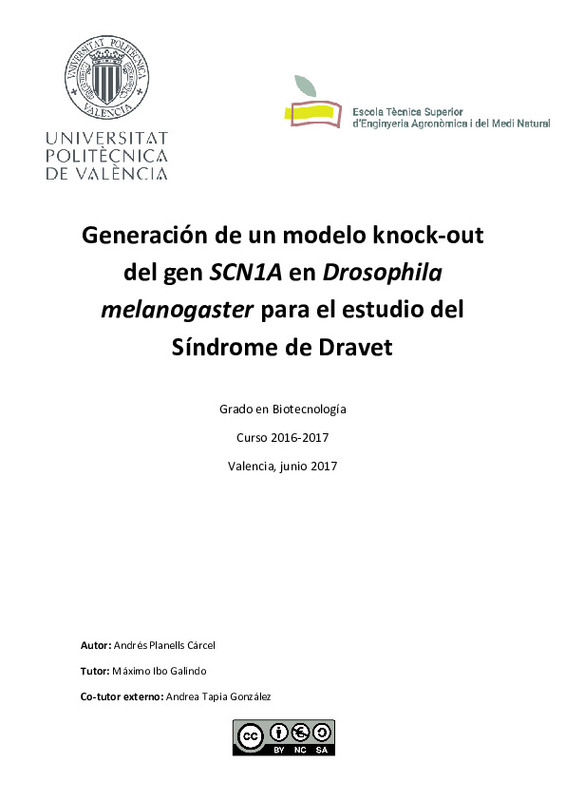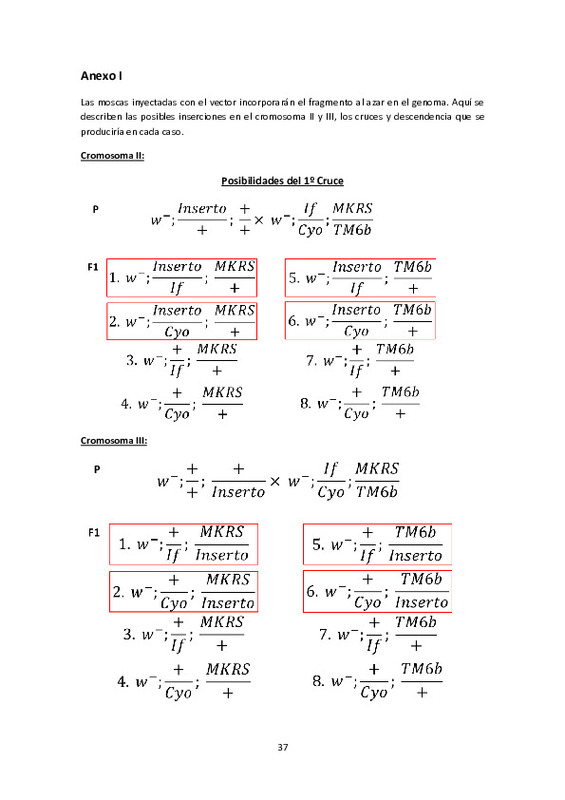JavaScript is disabled for your browser. Some features of this site may not work without it.
Buscar en RiuNet
Listar
Mi cuenta
Estadísticas
Ayuda RiuNet
Admin. UPV
Generación de un modelo knock-out del gen SCN1A en Drosophila melanogaster para el estudio del síndrome de Dravet
Mostrar el registro sencillo del ítem
Ficheros en el ítem
| dc.contributor.advisor | Galindo Orozco, Máximo Ibo
|
es_ES |
| dc.contributor.advisor | Tapia González, Andrea
|
es_ES |
| dc.contributor.author | Planells Cárcel, Andrés
|
es_ES |
| dc.date.accessioned | 2017-09-05T11:08:33Z | |
| dc.date.available | 2017-09-05T11:08:33Z | |
| dc.date.created | 2017-06-30 | |
| dc.date.issued | 2017-09-05 | es_ES |
| dc.identifier.uri | http://hdl.handle.net/10251/86417 | |
| dc.description.abstract | [ES] El Síndrome de Dravet (SD) es una enfermedad rara infantil que se manifiesta en crisis epilépticas a temprana edad y provoca un deterioro cognitivo y conductual. Esta enfermedad es causada por mutaciones dominantes en el gen SCN1A. Este trabajo se centra en la generación de un modelo knock-out (KO) del gen paralytic en Drosophila melanogaster, homólogo al gen SCN1A en humanos, para su aplicación en el estudio del SD. A la vez se ha estudiado la conducta de cepas sensibles a convulsionar tales como paralytic bangsenseless (para), easily shocked (eas) y slamdance (sda) realizando ensayos de supervivencia, de comportamiento, de escalada y de capacidad de vuelo. Se ha superado la etapa de biología molecular, obteniendo un plásmido efectivo para la recombinación homóloga que generará el KO, y también se ha conseguido obtener cepas transgénicas de D. melanogaster y mapear la localización del inserto en cada una de ellas. Estas cepas se utilizarán en un futuro para generar el KO de interés. En los ensayos se ha comprobado que la cepa con la mutación en el gen para es la que presenta un fenotipo más afectado en mosca adulta en comparación con el control, mostrando menor tasa de supervivencia, necesitando más tiempo para recuperarse tras una convulsión y escalando menor distancia en las paredes del tubo que el resto de genotipos. El genotipo eas solo mostró un comportamiento atípico en el ensayo de supervivencia y el comportamiento, manteniéndose normal en los ensayos de actividad locomotora. La cepa con la mutación en sda fue la que menos diferencias tuvo respecto al control, solo manifestando convulsiones de corta duración como diferencia. Estos ensayos han permitido aprender su correcta ejecución y han generado valores de referencia sobre los que comparar los resultados que se obtendrán con la mosca KO. Además, han puesto de manifiesto el importante defecto que genera una mutación puntual en el gen paralytic para la homeostasis en mosca adulta. | es_ES |
| dc.description.abstract | [EN] Dravet’s Syndrome (DS) is a rare childhood disease that causes epileptic seizures at early age and permanent cognitive and behavioral deterioration. This disease is caused by dominant mutations in the SCN1A gene. This work is focused on the generation of a knock-out (KO) model of the paralytic gene, the homologous gene of SCN1A human gen, in Drosophila melanogaster to study DS. At the same time, the bang-sensitive strains para, eas and sda have been characterized through survival, behavior, climbing and flight capacity tests. The stage of molecular biology for the obtaining of the KO has been achieved, obtaining an effective plasmid for homologous recombination. Moreover, different transgenic strains of D. melanogaster have been obtained and the location of the insert has been mapped in each one. These strains will be used in the future to generate the KO of interest. The tests have revealed that the strain with the mutation in gene para presents the most affected phenotype in adult flies. It shows a lower survival rate, needs more time to recover after a seizure and has less locomotor capacity than other phenotypes. The eas genotype showed an atypical behavior in survival and behavior tests, but it did not present any difference with control flies in the locomotor capacity tests. The strain with the mutation in sda was the one that exhibited less differences respect to the control, showing only short seizures. These tests have allowed to know the correct way to execute them, since they have generated reference values, useful to compare with the future KO fly results. In addition, they have revealed the important defects that a point mutation in the paralytic gene causes in the homeostasis of adult flies. | es_ES |
| dc.format.extent | 53 | es_ES |
| dc.language | Español | es_ES |
| dc.publisher | Universitat Politècnica de València | es_ES |
| dc.rights | Reconocimiento - No comercial - Compartir igual (by-nc-sa) | es_ES |
| dc.subject | Dravet syndrome | es_ES |
| dc.subject | Seizure | es_ES |
| dc.subject | Knock-out | es_ES |
| dc.subject | SCN1A | es_ES |
| dc.subject | Síndrome de Dravet | es_ES |
| dc.subject | Drosophila melanogaster | es_ES |
| dc.subject | Epilepsia | es_ES |
| dc.subject.classification | BIOQUIMICA Y BIOLOGIA MOLECULAR | es_ES |
| dc.subject.other | Grado en Biotecnología-Grau en Biotecnologia | es_ES |
| dc.title | Generación de un modelo knock-out del gen SCN1A en Drosophila melanogaster para el estudio del síndrome de Dravet | es_ES |
| dc.type | Proyecto/Trabajo fin de carrera/grado | es_ES |
| dc.rights.accessRights | Abierto | es_ES |
| dc.contributor.affiliation | Universitat Politècnica de València. Escuela Técnica Superior de Ingeniería Agronómica y del Medio Natural - Escola Tècnica Superior d'Enginyeria Agronòmica i del Medi Natural | es_ES |
| dc.contributor.affiliation | Universitat Politècnica de València. Departamento de Biotecnología - Departament de Biotecnologia | es_ES |
| dc.description.bibliographicCitation | Planells Cárcel, A. (2017). Generación de un modelo knock-out del gen SCN1A en Drosophila melanogaster para el estudio del síndrome de Dravet. http://hdl.handle.net/10251/86417 | es_ES |
| dc.description.accrualMethod | TFGM | es_ES |
| dc.relation.pasarela | TFGM\66474 | es_ES |
Este ítem aparece en la(s) siguiente(s) colección(ones)
-
ETSIAMN - Trabajos académicos [3541]
Escuela Técnica Superior de Ingeniería Agronómica y del Medio Natural







